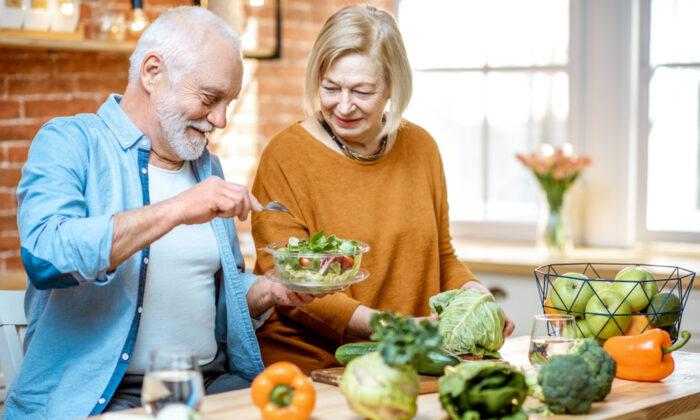For people over 40, joint pain and inflammation can become an unwelcome part of daily living.
For some, the condition is minor, with periodic flare-ups. For others, however, it is so debilitating that many activities of daily living come to a halt. Many people turn to pain medications and anti-inflammatories to ease their symptoms, but holistic body care should not be forgotten.
Painkillers and NSAIDs
Along with the potential for addiction, taking pain medications such as nonsteroidal anti-inflammatory drugs (NSAIDs), can have some serious drawbacks. In her book “Digestive Wellness,” Elizabeth Lipski, Ph.D., reports that NSAIDs can increase inflammation and block the body’s ability to regenerate cartilage tissue over time.
Medications in general are acid-forming and can lead to a softening of bones and osteoporosis in the long run. With excess acid, minerals, including calcium, get pulled out of the bone to neutralize acid levels, which compromises bone health.
In sharing these findings with arthritic sufferers, most are surprised, having been unaware of such medication risks. The bigger surprise comes in discussing the causes of osteoarthritis, since most people associate this condition only with the cartilage wear-and-tear that comes with age.
Secondary causes
The list of possible secondary causes of osteoarthritis is extensive and can include injury, such as bone fractures, and obesity, which puts excess pressure on the joints. Poor nutrition can also be a factor, since our bones and cartilage need nourishment just as much as any other part of the body.
Oestrogen plays a major role in regulating bone mass and strength, and oestrogen levels diminish with age. An underactive thyroid can contribute to osteoarthritic symptoms as well.
Infections are often overlooked as a secondary cause of arthritis. Bacteria from the mouth can travel to the synovial fluid of the knees and hips, leading to osteoarthritic symptoms. Bacterial migration from the colon to the small intestine can also result in body aches, among other symptoms.
Exposure to toxins, pesticides, chemicals, and heavy metals can lead to inflammation as well, affecting joints and tendons. Heavy metals, in particular, can be found in unfiltered water, the air, dental amalgams, aluminum cookware, and fish that are high in mercury.
One of the most unsuspected secondary causes of osteoarthritis is leaky gut syndrome. In this case, the small intestine literally develops leaks, and undigested foods enter the bloodstream. These foods then do not look familiar to the body, so the immune system steps in, leading to pain and inflammation.
Smart testing
Secondary arthritis usually presents itself at least a decade before the “wear-and-tear” type, which can be a clue to making an accurate diagnosis. With a broader understanding of the secondary causes and their timeframe, we can become more informed consumers. Rather than reflexively taking pain medication and anti-inflammatories, we can ask our doctors to run tests to determine the less obvious causes.
For example, if bacteria are involved, infections need to be treated. If heavy metal levels are high, a detoxification program will be recommended. Leaky gut can be addressed by choosing certain supplements, such as aloe vera and glutamine, to help with intestinal repair.
As these examples show, just treating the osteoarthritic symptoms of pain and inflammation will not address secondary causes that lie underneath.
Nutrition
Along with targeted treatments, nutritional choices and lifestyle changes can help with pain and inflammation, as well as to nourish and regenerate our joints.
First and foremost, think in terms of reducing acid-forming foods, such as beef, eggs, and cottage cheese. High-protein diets, coffee, and alcohol can acidify the blood as well.
Sodas contain phosphates, which leach calcium from bones and should be avoided altogether. Low-starch fruits and vegetables, on the other hand, are alkalizing to the body and should be consumed daily.
A plant-based diet is high in antioxidants, which help to fight inflammation. Anti-inflammatory vegetables include arugula, asparagus, broccoli, cabbage, cauliflower, kale, onions, parsley, radishes, and spinach. Blueberries, blackberries, raspberries, strawberries, cranberries, tart cherries, mangoes, papaya, and watermelon are also anti-inflammatory foods.
With osteoarthritis, you also need to be aware of the types of fats consumed. Saturated fats and trans-fats can increase inflammation in the body. Focus on foods containing omega-3 fatty acids instead, as they help to reduce inflammation. Cold-water fish, such as salmon, cod, herring, and mackerel, as well as walnuts, flaxseeds, and extra virgin olive oil can help to reduce inflammation.
Some foods in the nightshade family have substances called alkaloids that can interfere with collagen repair and increase inflammation in the body. Many arthritis sufferers have found considerable relief by eliminating nightshade foods such as potatoes, tomatoes, and chili peppers, as well as nicotine.
Allergens
Since food allergies can trigger osteoarthritic symptoms, try eliminating common allergens and monitor osteoarthritis symptoms. Eliminate corn, wheat, dairy, sugar, meat, beef, soy, and citrus for two weeks. Re-introduce each food for three days and monitor reactions.
Although it may be hard for many of us, as creatures of habit, to choose a variety of foods in our diets, it can be well worth it. Varying foods helps to minimize developing allergies.
Detoxification
There has rarely been someone I have spoken to who reported chewing food well. But in terms of osteoarthritis, undigested food particles can lead to allergic reactions and inflammation. Try to be a more mindful eater, chewing slowly and relishing each bite.
Given the potential role of heavy metals and other toxins in osteoarthritis, be aware that there are foods that can help with detoxification, especially organic fresh fruit and non-starchy vegetables. Cruciferous vegetables such as arugula, bok choy, broccoli, brussels sprouts, cabbage, cauliflower, kale, and watercress are especially helpful with detoxification.
Herbal teas such as dandelion and milk thistle are also supportive of detoxification. Three to four cups daily can help to clear toxins from your body. Drink lots of water to flush out toxins and lubricate the joints as well.
Supplements
Supplementation with high quality supplements without fillers or dyes can help with pain and inflammation. Some supplements may be more effective than others, and it depends on the individual. It is highly advisable to work under the supervision of a physician or nutritionist who is knowledgeable about alternatives to anti-inflammatory drugs.
A high-quality multivitamin with minerals is always recommended to fill any nutritional gaps. Vitamin B complex, vitamin C ascorbate, ginger, bromelain, quercetin, and MSM (methyl sulfonyl methane) can all help to reduce pain and inflammation.
Gamma-linolenic acid found in olive oil, borage oil, evening primrose oil, and omega-3 fatty acids has similar effects. Additional anti-inflammatories include turmeric and curcumin, devil’s claw, black cohosh, and cayenne pepper.
MSM, glucosamine sulfate, and condroitin can help to reduce inflammation and repair cartilage. In his book “Total Body Tune-Up,” Michael Murray, N.D., cites studies showing that condroitin may be less effective than glucosamine sulfate. This is due to absorption problems, since condroitin molecules are larger compared to glucosamine.
Always consult with a professional about proper dosing, rather than experimenting on your own.
Exercise
Lastly, but equally important, is the role of exercise in treating osteoarthritis. Mild forms of exercise can help to reduce stiffness, pain, and joint tenderness, as well as increase range of motion. In addition, exercise can help to repair cartilage and reduce stress on the joints, along with emotional stress. Never underestimate the impact of emotional stress on your body, including joints.
It usually takes many years for the effects of osteoarthritis to creep up, and changes cannot be made in a day. But there are ways to test for underlying causes and to find relief through diet, lifestyle changes, and supplementation. Little by little, these changes can bring enjoyment, freedom of movement, and peace of mind. A little patience goes a long way.
June Rousso, Ph.D., is a licensed psychologist with a private practice in New York City. She is a graduate of the New School for Social Research and is currently studying holistic nutrition at Hawthorn University.





